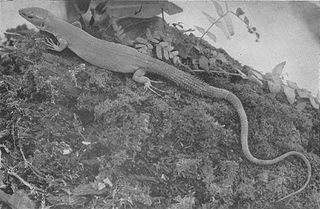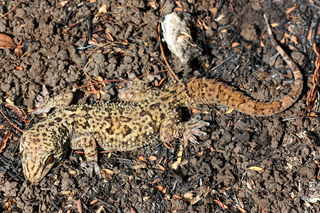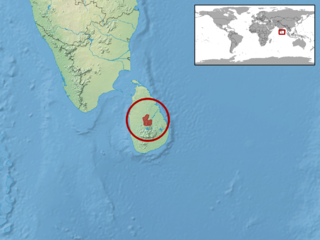
Ceratophora is a genus of agamid lizards found in Sri Lanka. The male has a horn on its snout.

Gastropholis is a genus of Equatorial African lacertid lizards of the family Lacertidae which is distributed in southern Liberia, Ivory Coast and Ghana, western Cameroon, Equatorial Guinea, Democratic Republic of Congo, eastern Kenya, Tanzania and south to northeastern Mozambique.

Holaspis is a genus of equatorial African lizards in the family Lacertidae. These lizards are capable of gliding flight for distances of 30 meters.

Philochortus is a genus of lizards of the family Lacertidae. Species of this genus are distributed in Egypt, Algeria, Libya, Mali, Niger, Ethiopia, Djibouti, Eritrea, Somalia, Kenya, Yemen, and Saudi Arabia.

Pseuderemias is a genus of lizards of the family Lacertidae. Common names for the genus are false sand lizards or racerunners.

Takydromus is a genus of lizards, commonly called grass lizards or oriental racers. Species of the genus Takydromus are endemic to a large part of Asia. Members of this genus are noticeable because of their slender appearance and their agile movements. The word takydromus derives from Greek ταχυδρόμος (takhudromos), "fast-running", from ταχύς (takhus), "swift" + δρόμος (dromos), "course, race".

The common trinket snake is a nonvenomous constrictor species of colubrid snake native to south Central Asia.

Hemidactylus brookii, also known commonly as Brooke's house gecko and the spotted house gecko, is a widespread species of lizard in the family Gekkonidae.

Hemidactylus maculatus, also known as the spotted leaf-toed gecko or giant spotted gecko, is a species of large gecko found in the Western Ghats of India and in parts of Sri Lanka.
Jerdon's day gecko is a species of gecko, a lizard in the family Gekkonidae. The species is endemic to India and Sri Lanka.

The Kandyan day gecko or Kandyan rock gecko is a species of diurnal gecko found in Sri Lanka.

The Indian fringe-fingered lizard, also known commonly as the Indian fringe-toed lizard, is a species of lizard in the family Lacertidae. The species is endemic to Asia.

Ophisops elegans, commonly known as the snake-eyed lizard, is a species of lizard in the family Lacertidae. The species is endemic to the Mediterranean region and Central Asia. There are nine recognized subspecies.

Ophisops jerdonii, commonly known as Jerdon's cabrita, Jerdon's snake-eye, or Punjab snake-eyed lacerta, is a species of lacertid lizard, which is distributed in east Afghanistan, Pakistan, and India.

Ophisops leschenaultii, commonly called Leschenault's snake-eye, Leschenault’s lacerta, or Leschenault's cabrita, is a species of lacertid lizard endemic to India and eastern Sri Lanka. In Sri Lanka, this lizard is called Pandura katussa in Sinhala. In some parts of the country, it is also called Heeraluwa or sikanala, which is more common name for all skink-like reptiles.
Ophiomorus tridactylus, commonly known as the three-toed snake skink, is a species of skink endemic to sandy desert areas of South Asia. It is also called the Indian sand-swimmer for its habit of moving just under the sand.
Polemon gabonensis, or the Gaboon snake-eater, is a species of venomous rear-fanged snake in the family Atractaspididae. It is endemic to Africa.

Toxicodryas blandingii, commonly known as Blanding's cat snake, Blanding's tree snake, and Blandings [sic] tree snake, is a species of rear-fanged venomous snake of the family Colubridae. The species is endemic to Sub-Saharan Africa.
The helmeted worm lizard is a species of amphisbaenian in the family Amphisbaenidae. The species is native to the west coast of Central Africa.
Nucras boulengeri, also known commonly as the Uganda savannah lizard and Boulenger's scrub lizard, is a species of lizard in the family Lacertidae. The species is native to East Africa.















